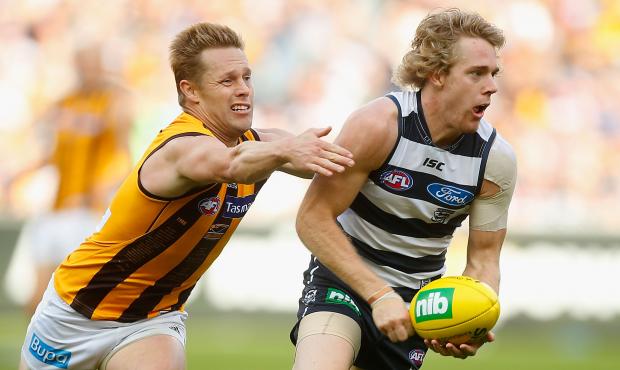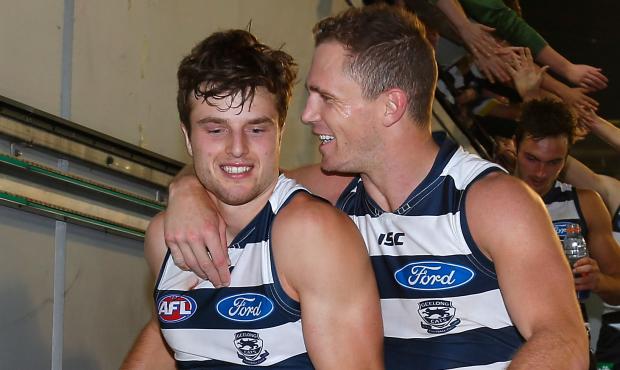That this football club has been able to keep itself at or near the top of the ladder every season since a breakthrough premiership in 2007 is already one of the great chapters of VFL/AFL history.
And this rolling story is nowhere near completion.
In 2014, Geelong, on the back of hard and calculated off-season decisions, has rejuvenated itself, yet again.
Strong clubs make the hard decisions. Weak clubs think about making the hard decisions before baulking, and then convincing itself that the easy decision was the right one.
Telling Paul Chapman last September that his time as a Geelong player was finished was not easy. Nor was giving Joel Corey, Josh Hunt and James Podsiadly the same message.
Initially none of the quartet thought his time was up. Chapman was lured to Essendon, Hunt to GWS, Podsiadly to Adelaide and Corey, after going to the wire on a playing offer from GWS, settled for being an assistant coach with Western Bulldogs.
At no stage did the club make Chapman and co feel less about themselves, and at no stage did the players criticise the club for moving them on.
The easy decision would have been to keep all players, let them play out their fine careers as Cats.
When Chapman started 2014 with a flurry of goals for the Bombers, the Geelong faithful, hurt last year when one of their all-time favourites was cut, again had reason to pine.
But the Geelong officials who made the decision have never looked back, not even after Chapman’s stunning opening to the year.
Five weeks in, we all now know why.
In Chapman’s absence, Cameron Guthrie has gone to extraordinary new levels. He’s hard, like Chapman, and he’s developed an engine, as Chapman did as his career unfolded.
In 40 matches before this year, he averaged 12 disposals. He’s up to 16 average disposals in 2014, and has been sent to the game’s best midfielders in Scott Pendlebury and Patrick Dangerfield.
Guthrie has been at an average 16 centre bounces per game this year, ranked third at the Cats and up from just six per match in 2013.
Cam Guthrie gives Sam Mitchell the slip at the MCG on Monday. Picture: AFL Media

Then there’s George Horlin-Smith (pre-2014 average disposals at 14, in 2014 it has been 17.3), George Burbury, and until he got injured, Josh Caddy, who too have benefitted from the roles being asked of them in a Cats team minus Chapman, Corey and Hunt.
Jordan Murdoch is being given more responsibility up forward, and is getting more of the football as a result (average 14 disposals this year against 10 before this year).
Geelong got a glimpse of a Chapman-less future last year when injury and a late-season suspension restricted him to just eight matches, and if Geelong didn’t make the call on him post-season, it would have been obliged to play him this year.
Which would have meant one of the younger players would have been stuck in the VFL this year, and open to an offer from a rival club come October.
Geelong is going to be right in the premiership mix again in 2014, and the stellar form this year is even more impressive when the injury list is factored in.
Steven Motlop, Allen Christensen, Nathan Vardy, Josh Caddy, Billie Smedts, Daniel Menzel. All brilliant young players and all unavailable for large chunks of time. All bar Vardy are aiming to be pushing for senior selection at some stage of 2014.

When Geelong made the tough decisions last year on the champion players, it impacted on the senior players who remained as much as it did the fanatical supporters.
In keeping with this club’s player empowerment systems, some players questioned the Chapman situation, unsure if it was the right outcome that he and the others were to become opponents in 2014.
It was a natural response. But the players have always not just backed the people who make the hard decisions at their club, they trust them to make the right decisions for their club.
Players at Geelong are told a year early rather than a year late that their time is up. Matthew Scarlett, Brad Ottens, Cameron Ling and Tom Harley all had similar conversations to Chapman, and all retired with something in the tank.
When it came to Cam Mooney, Darren Milburn, Max Rooke and David Wojcinski, they were on empty, but again, the hard decisions were made for them, and they signed-off.
Gary Ablett’s departure was unique, as he virtually had no choice but to accept the lucrative deal from Gold Coast, and Shannon Byrnes’ time as a Cat was finished the moment Melbourne offered him a substantial package.
Chris Scott, before he took over as coach of the Cats in 2011, was a key player in a team arguably even more successful than Geelong.
After four Grand Finals in a row, the Lions made the finals just once in the next nine seasons, and you can make that one finals series from 10 by the time this year is complete.
When Scott finished as a player, he was totally spent, and because of injuries had been for a very long time. One of his assistant coaches at Geelong, Nigel Lappin, finished in similar condition.
Other great Lions, Michael Voss included and even Jonathan Brown who is still playing, clearly never had someone at their club who was prepared to have the conversations that Chapman and co have had with Geelong officials.
Breaking up with a loved one is always painful. But when it comes to footy, staying with a loved one can sometimes be more painful.
Twitter: @barrettdamian



